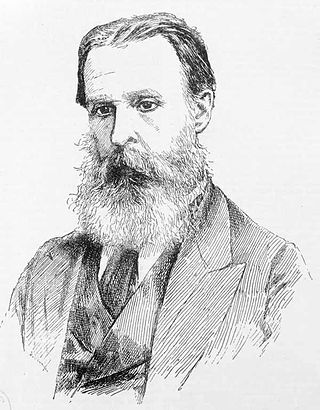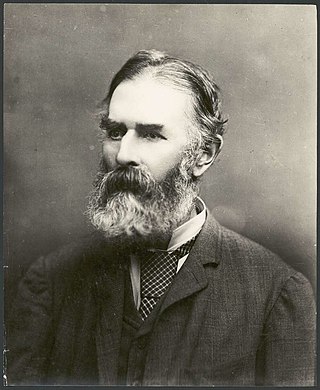
The Yarra River or historically, the Yarra Yarra River, is a perennial river in south-central Victoria, Australia.

Port Melbourne is an inner-city suburb in Melbourne, Victoria, Australia, 3 km (2 mi) south of the Melbourne central business district, located within the Cities of Melbourne and Port Phillip local government areas. Port Melbourne recorded a population of 17,633 at the 2021 census.

The Port of Melbourne is the largest port for containerised and general cargo in Australia. It is located in Melbourne, Victoria, and covers an area at the mouth of the Yarra River, downstream of Bolte Bridge, which is at the head of Port Phillip, as well as several piers on the bay itself. Since 1 July 2003, the Port of Melbourne has been managed by the Port of Melbourne Corporation, a statutory corporation created by the State of Victoria.

Polly Woodside is a Belfast-built, three-masted, iron-hulled barque, preserved in Melbourne, Victoria (Australia), and forming the central feature of the South Wharf precinct. The ship was originally built in Belfast by William J. Woodside and was launched in 1885. Polly Woodside is typical of thousands of smaller iron barques built in the last days of sail, intended for deep water trade around the world and designed to be operated as economically as possible.

Sir John Coode, English civil engineer, known for harbour works.

Coode Island is a former island at the convergence of the Yarra and Maribyrnong Rivers, 4 km west of central Melbourne, Australia. The island was formed by the excavation of the Coode Canal in 1887, and became connected to the mainland in the 1930s. Today the low-lying land is part of the Port of Melbourne, and is used as the site of Swanson and Appleton Docks and their associated container storage and rail yards, as well as a number of chemical storage facilities.

The Morell Bridge is an arch bridge over the Yarra River in South Yarra, Melbourne, Victoria, Australia. Completed in 1899 by John Monash and J. T. N. Anderson, it is notable as the first bridge in Victoria that was built using reinforced concrete.
Melbourne West Province was an electorate of the Victorian Legislative Council from 1904 until 2006.

The Port of Melbourne Corporation (PoMC) is a statutory body established by the Victorian Government to develop and manage the Port of Melbourne, Australia's busiest container port. The Corporation commenced operations on 1 July 2003, when it took over the management of the port from the Melbourne Port Corporation. On 1 September 2010, the corporation was re-established with a new charter under the Transport Integration Act.

Fremantle Harbour is Western Australia's largest and busiest general cargo port and an important historical site. The inner harbour handles a large volume of sea containers, vehicle imports and livestock exports, cruise shipping and naval visits, and operates 24 hours a day. It is located adjacent to the city of Fremantle, in the Perth metropolitan region.

The West Melbourne Swamp also known as Batman's Swamp, was a large saltwater wetland located to the west of the city of Melbourne, Victoria. It was an important resource for Aboriginal people.

William Thwaites (1853–1907) was a civil engineer working in Melbourne, Australia in the late nineteenth and early twentieth centuries. He was responsible for the design and supervision of construction of Melbourne's sewerage system.
The Melbourne Harbor Trust was established in 1877 to improve and operate port facilities for the growing city of Melbourne. It was superseded by the Port of Melbourne Authority in 1978 and later by the Port of Melbourne Corporation.
Joseph Brady was an Irish born, civil engineer active in Queensland, New South Wales and Victoria, Australia, in the late nineteenth and early twentieth century, undertaking works on railways, water supplies and ports. Among his more important works were the Coliban Water Supply for Bendigo, and Melbourne Port improvements.

Victoria Dock also known as Victoria Harbour is a large excavated harbour basin located off Footscray Road and Docklands Highway, Docklands, in Melbourne. It was constructed between 1887 and 1892, under the supervision of Melbourne Harbor Trust engineer Joseph Brady, to modified designs of British engineer Sir John Coode.
There are few canals in Australia. Of the canals constructed, only a small number are navigable waterways. The following list provides a summary of known navigable waterways and other types of constructed or artificial waterways in Australia.
The Wailing Wall is a section of brick retaining wall on the Flinders Street Extension, Melbourne, which is famous as the place where Wharf labourers who missed out on the daily work call would congregate.
Sir James Lorimer was an Australian politician and businessman. He was the first chairman of the Melbourne Harbor Trust and a Member of the Legislative Council in the Victorian parliament from 1879 to 1889.

Swanson Dock is an international shipping facility in Melbourne, Victoria, Australia. It was constructed between 1966 and 1972 by the Melbourne Harbor Trust, leading off the north bank of the Yarra River, to alleviate congestion in the port and provide Melbourne's first container shipping terminal. It is located about 2 km downstream from the Melbourne CBD and was named after Victor Swanson, chairman of the Melbourne Harbor Trust from 1960 to 1972.

Edward Orpen Moriarty (1824–1896) MA MInstCE was an Australian civil engineer, who undertook a number of important public works in New South Wales in the late nineteenth century.














